Corporations and Business Structures: Legal Responsibilities Report
VerifiedAdded on 2022/08/26
|14
|3345
|22
Report
AI Summary
This report delves into the legal responsibilities of corporations and their stakeholders, specifically focusing on the Corporations Act 2001 (Cth). It analyzes a case study involving SRT Pty Ltd, its directors (Sam and Rosa), shareholders, and partners (Charlotte and Mia), and a 'de facto' director (Phillipa). The report examines potential breaches of director duties, including the misuse of position and information, insolvent trading, and the failure to act with diligence and good faith. It explores the fiduciary duties of partners and the consequences of failing to disclose relevant information. The analysis incorporates key legal concepts, relevant case law (e.g., Queensland Mines Ltd vs. Hudson, Adler vs. ASIC, Daniels vs. Anderson), and the potential legal consequences of any breaches. The report concludes by outlining steps the parties could have taken to address their legal responsibilities, offering a comprehensive overview of corporate law and its practical implications. The report is divided into two IRAC analyses, addressing different aspects of the legal issues presented.
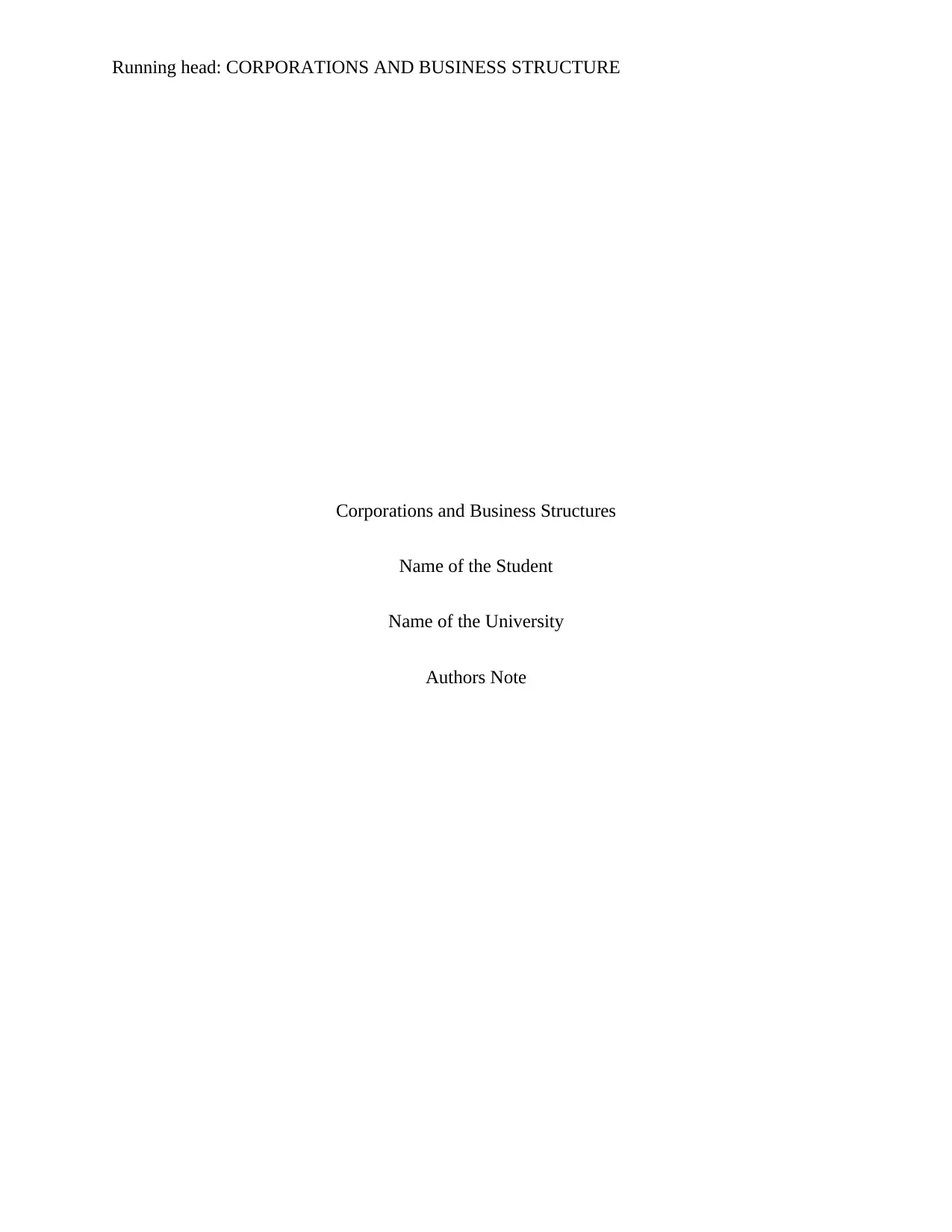
Running head: CORPORATIONS AND BUSINESS STRUCTURE
Corporations and Business Structures
Name of the Student
Name of the University
Authors Note
Corporations and Business Structures
Name of the Student
Name of the University
Authors Note
Paraphrase This Document
Need a fresh take? Get an instant paraphrase of this document with our AI Paraphraser
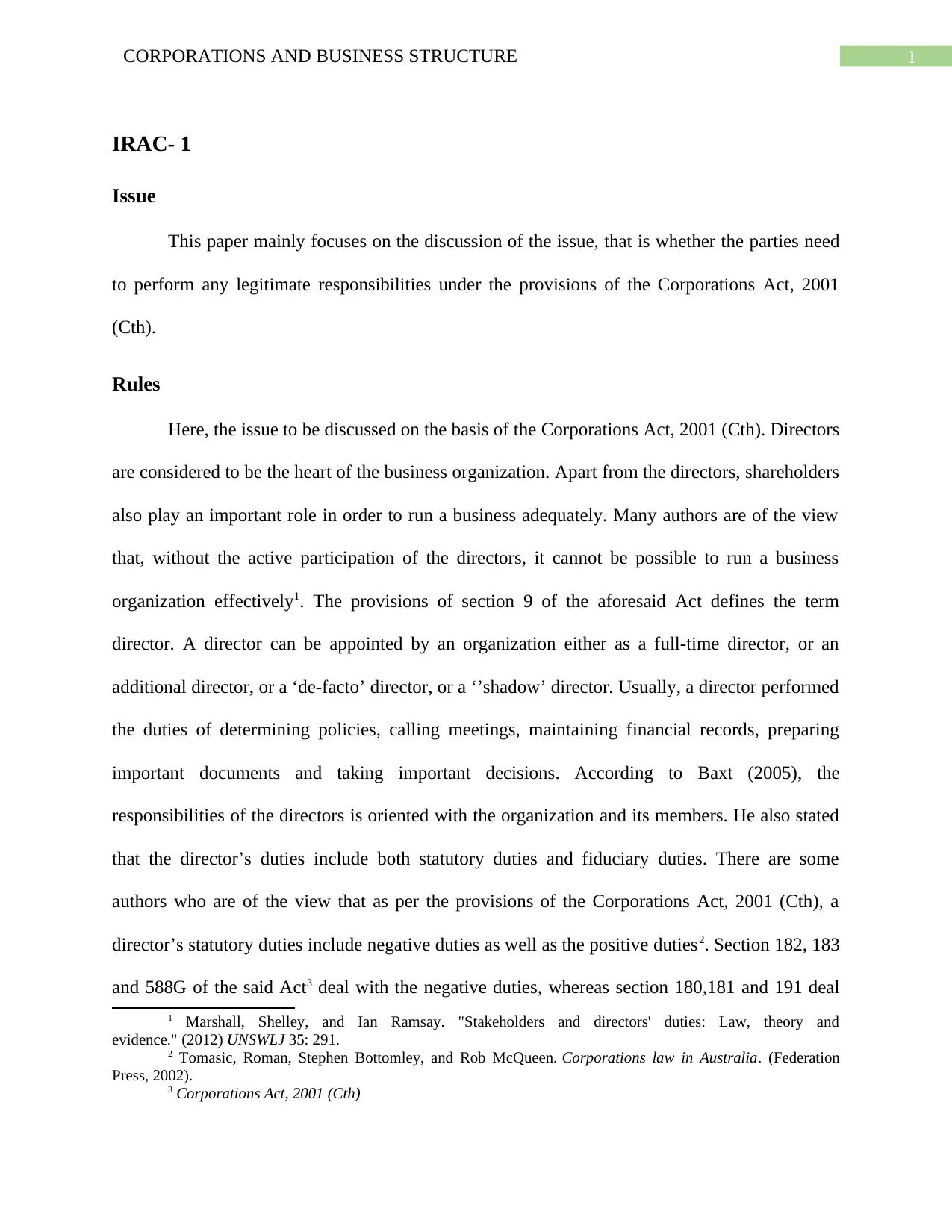
1CORPORATIONS AND BUSINESS STRUCTURE
IRAC- 1
Issue
This paper mainly focuses on the discussion of the issue, that is whether the parties need
to perform any legitimate responsibilities under the provisions of the Corporations Act, 2001
(Cth).
Rules
Here, the issue to be discussed on the basis of the Corporations Act, 2001 (Cth). Directors
are considered to be the heart of the business organization. Apart from the directors, shareholders
also play an important role in order to run a business adequately. Many authors are of the view
that, without the active participation of the directors, it cannot be possible to run a business
organization effectively1. The provisions of section 9 of the aforesaid Act defines the term
director. A director can be appointed by an organization either as a full-time director, or an
additional director, or a ‘de-facto’ director, or a ‘’shadow’ director. Usually, a director performed
the duties of determining policies, calling meetings, maintaining financial records, preparing
important documents and taking important decisions. According to Baxt (2005), the
responsibilities of the directors is oriented with the organization and its members. He also stated
that the director’s duties include both statutory duties and fiduciary duties. There are some
authors who are of the view that as per the provisions of the Corporations Act, 2001 (Cth), a
director’s statutory duties include negative duties as well as the positive duties2. Section 182, 183
and 588G of the said Act3 deal with the negative duties, whereas section 180,181 and 191 deal
1 Marshall, Shelley, and Ian Ramsay. "Stakeholders and directors' duties: Law, theory and
evidence." (2012) UNSWLJ 35: 291.
2 Tomasic, Roman, Stephen Bottomley, and Rob McQueen. Corporations law in Australia. (Federation
Press, 2002).
3 Corporations Act, 2001 (Cth)
IRAC- 1
Issue
This paper mainly focuses on the discussion of the issue, that is whether the parties need
to perform any legitimate responsibilities under the provisions of the Corporations Act, 2001
(Cth).
Rules
Here, the issue to be discussed on the basis of the Corporations Act, 2001 (Cth). Directors
are considered to be the heart of the business organization. Apart from the directors, shareholders
also play an important role in order to run a business adequately. Many authors are of the view
that, without the active participation of the directors, it cannot be possible to run a business
organization effectively1. The provisions of section 9 of the aforesaid Act defines the term
director. A director can be appointed by an organization either as a full-time director, or an
additional director, or a ‘de-facto’ director, or a ‘’shadow’ director. Usually, a director performed
the duties of determining policies, calling meetings, maintaining financial records, preparing
important documents and taking important decisions. According to Baxt (2005), the
responsibilities of the directors is oriented with the organization and its members. He also stated
that the director’s duties include both statutory duties and fiduciary duties. There are some
authors who are of the view that as per the provisions of the Corporations Act, 2001 (Cth), a
director’s statutory duties include negative duties as well as the positive duties2. Section 182, 183
and 588G of the said Act3 deal with the negative duties, whereas section 180,181 and 191 deal
1 Marshall, Shelley, and Ian Ramsay. "Stakeholders and directors' duties: Law, theory and
evidence." (2012) UNSWLJ 35: 291.
2 Tomasic, Roman, Stephen Bottomley, and Rob McQueen. Corporations law in Australia. (Federation
Press, 2002).
3 Corporations Act, 2001 (Cth)
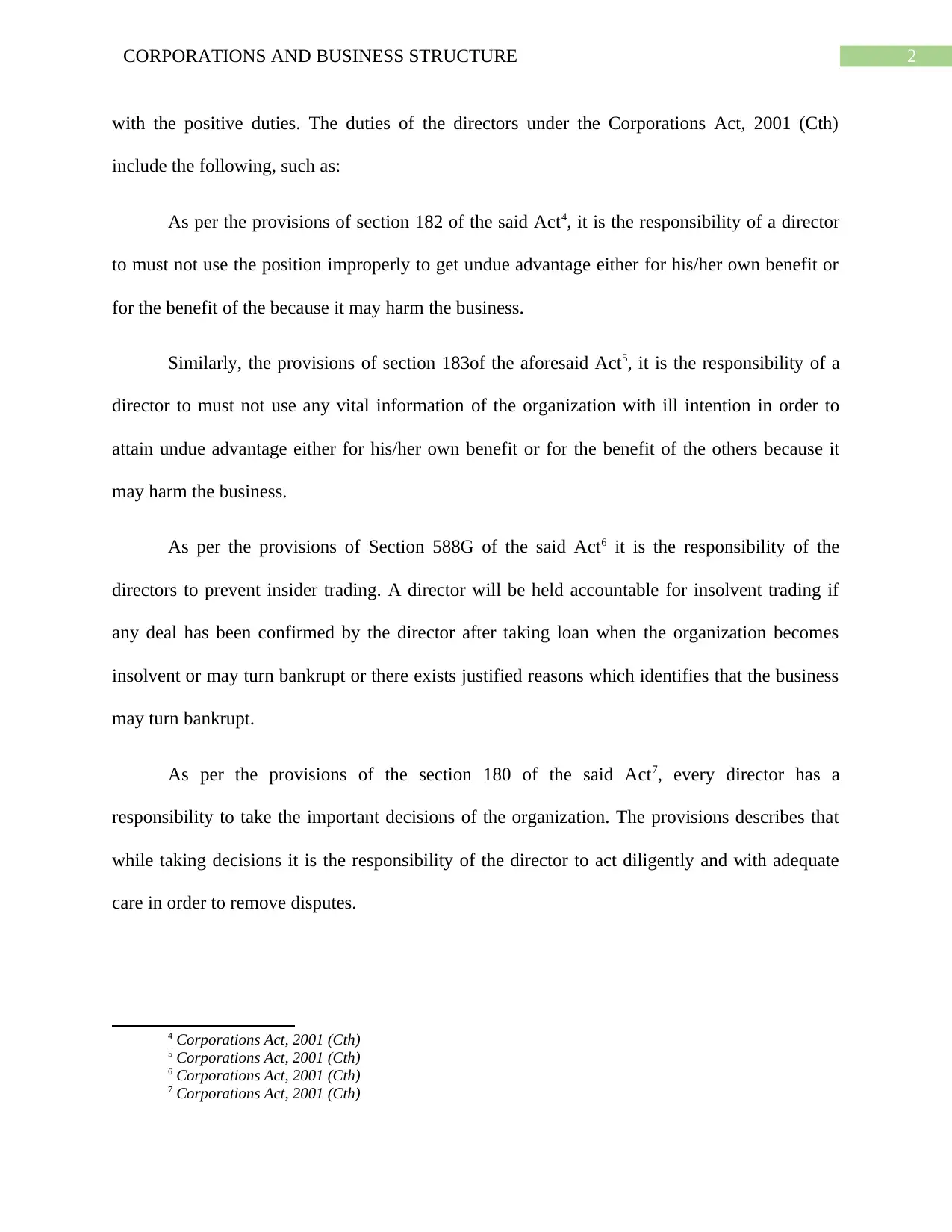
2CORPORATIONS AND BUSINESS STRUCTURE
with the positive duties. The duties of the directors under the Corporations Act, 2001 (Cth)
include the following, such as:
As per the provisions of section 182 of the said Act4, it is the responsibility of a director
to must not use the position improperly to get undue advantage either for his/her own benefit or
for the benefit of the because it may harm the business.
Similarly, the provisions of section 183of the aforesaid Act5, it is the responsibility of a
director to must not use any vital information of the organization with ill intention in order to
attain undue advantage either for his/her own benefit or for the benefit of the others because it
may harm the business.
As per the provisions of Section 588G of the said Act6 it is the responsibility of the
directors to prevent insider trading. A director will be held accountable for insolvent trading if
any deal has been confirmed by the director after taking loan when the organization becomes
insolvent or may turn bankrupt or there exists justified reasons which identifies that the business
may turn bankrupt.
As per the provisions of the section 180 of the said Act7, every director has a
responsibility to take the important decisions of the organization. The provisions describes that
while taking decisions it is the responsibility of the director to act diligently and with adequate
care in order to remove disputes.
4 Corporations Act, 2001 (Cth)
5 Corporations Act, 2001 (Cth)
6 Corporations Act, 2001 (Cth)
7 Corporations Act, 2001 (Cth)
with the positive duties. The duties of the directors under the Corporations Act, 2001 (Cth)
include the following, such as:
As per the provisions of section 182 of the said Act4, it is the responsibility of a director
to must not use the position improperly to get undue advantage either for his/her own benefit or
for the benefit of the because it may harm the business.
Similarly, the provisions of section 183of the aforesaid Act5, it is the responsibility of a
director to must not use any vital information of the organization with ill intention in order to
attain undue advantage either for his/her own benefit or for the benefit of the others because it
may harm the business.
As per the provisions of Section 588G of the said Act6 it is the responsibility of the
directors to prevent insider trading. A director will be held accountable for insolvent trading if
any deal has been confirmed by the director after taking loan when the organization becomes
insolvent or may turn bankrupt or there exists justified reasons which identifies that the business
may turn bankrupt.
As per the provisions of the section 180 of the said Act7, every director has a
responsibility to take the important decisions of the organization. The provisions describes that
while taking decisions it is the responsibility of the director to act diligently and with adequate
care in order to remove disputes.
4 Corporations Act, 2001 (Cth)
5 Corporations Act, 2001 (Cth)
6 Corporations Act, 2001 (Cth)
7 Corporations Act, 2001 (Cth)
⊘ This is a preview!⊘
Do you want full access?
Subscribe today to unlock all pages.

Trusted by 1+ million students worldwide
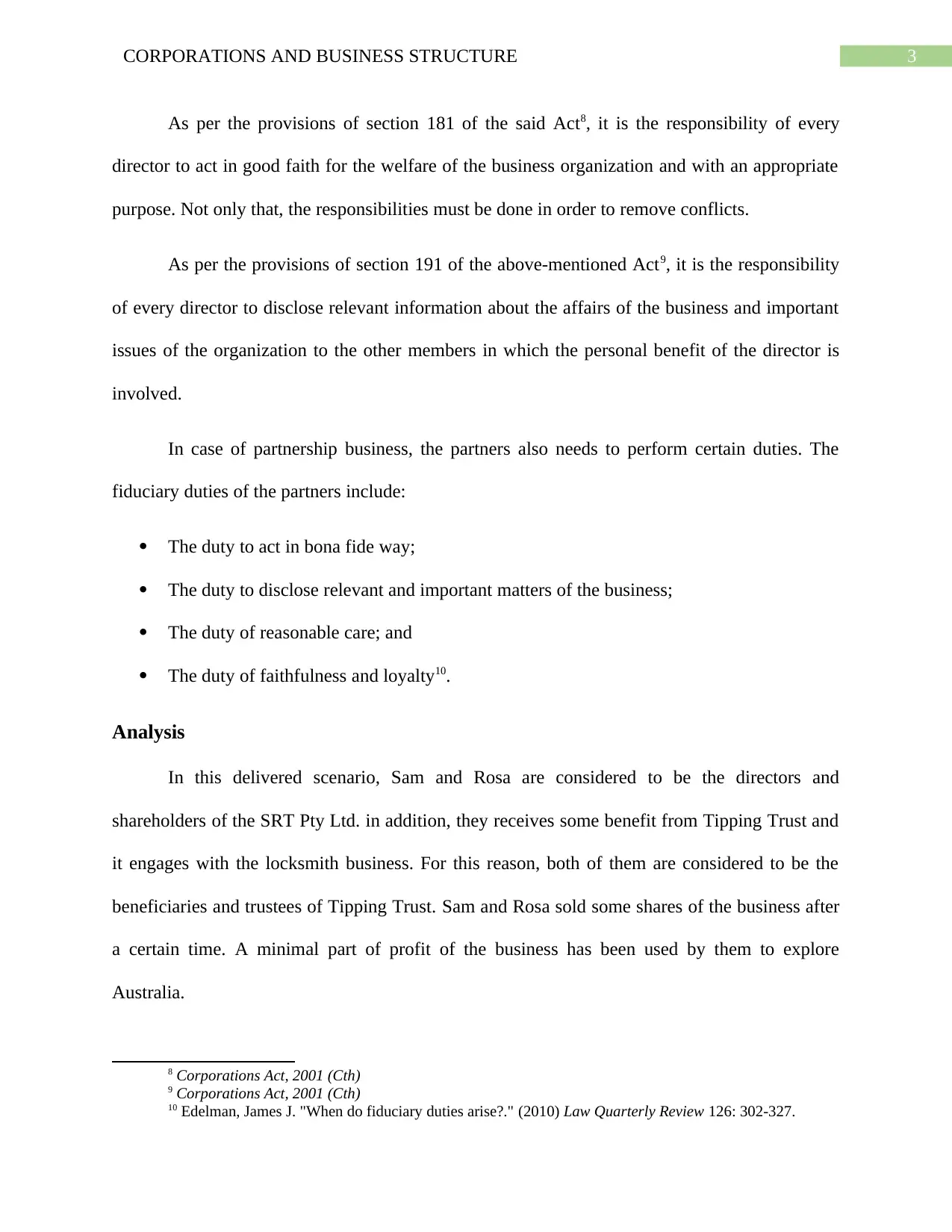
3CORPORATIONS AND BUSINESS STRUCTURE
As per the provisions of section 181 of the said Act8, it is the responsibility of every
director to act in good faith for the welfare of the business organization and with an appropriate
purpose. Not only that, the responsibilities must be done in order to remove conflicts.
As per the provisions of section 191 of the above-mentioned Act9, it is the responsibility
of every director to disclose relevant information about the affairs of the business and important
issues of the organization to the other members in which the personal benefit of the director is
involved.
In case of partnership business, the partners also needs to perform certain duties. The
fiduciary duties of the partners include:
The duty to act in bona fide way;
The duty to disclose relevant and important matters of the business;
The duty of reasonable care; and
The duty of faithfulness and loyalty10.
Analysis
In this delivered scenario, Sam and Rosa are considered to be the directors and
shareholders of the SRT Pty Ltd. in addition, they receives some benefit from Tipping Trust and
it engages with the locksmith business. For this reason, both of them are considered to be the
beneficiaries and trustees of Tipping Trust. Sam and Rosa sold some shares of the business after
a certain time. A minimal part of profit of the business has been used by them to explore
Australia.
8 Corporations Act, 2001 (Cth)
9 Corporations Act, 2001 (Cth)
10 Edelman, James J. "When do fiduciary duties arise?." (2010) Law Quarterly Review 126: 302-327.
As per the provisions of section 181 of the said Act8, it is the responsibility of every
director to act in good faith for the welfare of the business organization and with an appropriate
purpose. Not only that, the responsibilities must be done in order to remove conflicts.
As per the provisions of section 191 of the above-mentioned Act9, it is the responsibility
of every director to disclose relevant information about the affairs of the business and important
issues of the organization to the other members in which the personal benefit of the director is
involved.
In case of partnership business, the partners also needs to perform certain duties. The
fiduciary duties of the partners include:
The duty to act in bona fide way;
The duty to disclose relevant and important matters of the business;
The duty of reasonable care; and
The duty of faithfulness and loyalty10.
Analysis
In this delivered scenario, Sam and Rosa are considered to be the directors and
shareholders of the SRT Pty Ltd. in addition, they receives some benefit from Tipping Trust and
it engages with the locksmith business. For this reason, both of them are considered to be the
beneficiaries and trustees of Tipping Trust. Sam and Rosa sold some shares of the business after
a certain time. A minimal part of profit of the business has been used by them to explore
Australia.
8 Corporations Act, 2001 (Cth)
9 Corporations Act, 2001 (Cth)
10 Edelman, James J. "When do fiduciary duties arise?." (2010) Law Quarterly Review 126: 302-327.
Paraphrase This Document
Need a fresh take? Get an instant paraphrase of this document with our AI Paraphraser
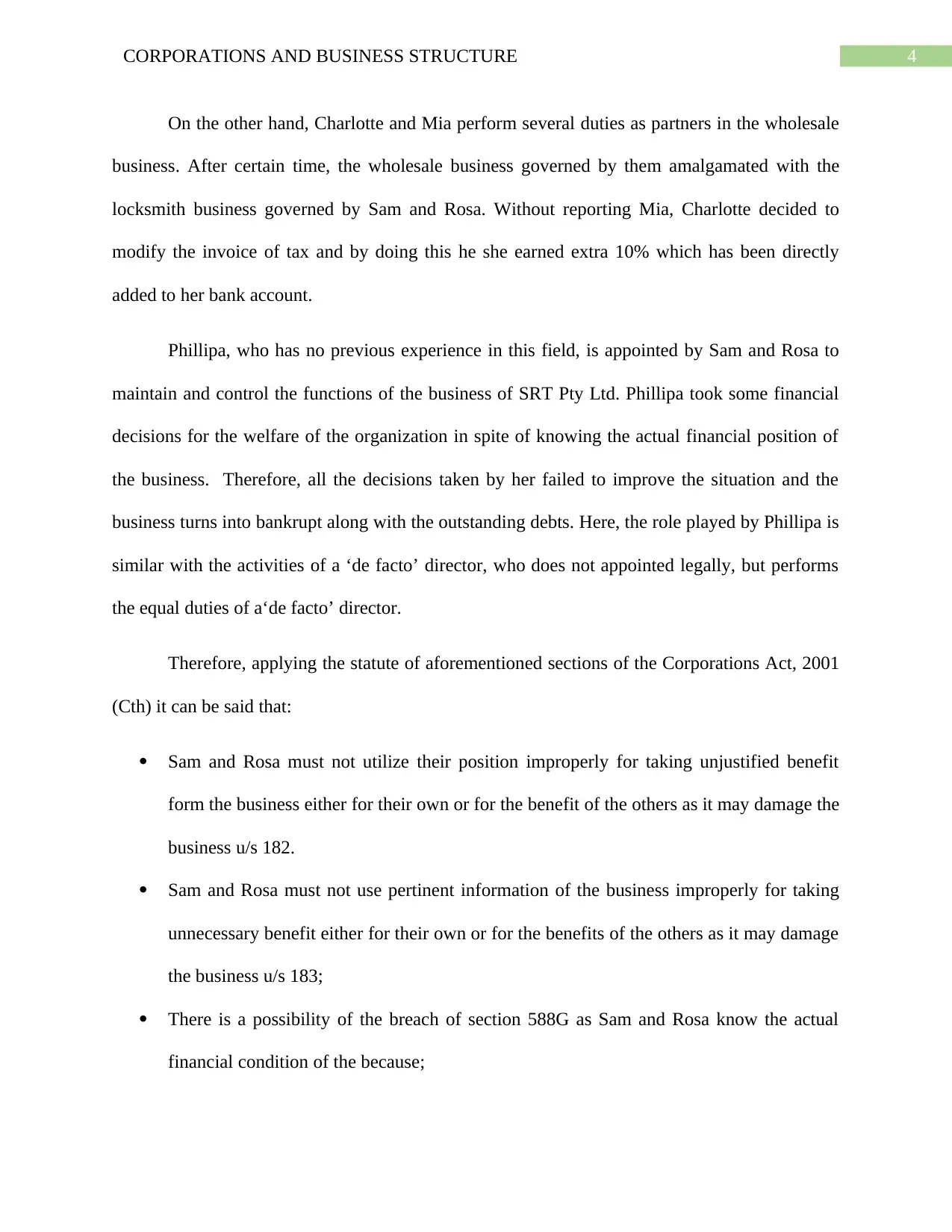
4CORPORATIONS AND BUSINESS STRUCTURE
On the other hand, Charlotte and Mia perform several duties as partners in the wholesale
business. After certain time, the wholesale business governed by them amalgamated with the
locksmith business governed by Sam and Rosa. Without reporting Mia, Charlotte decided to
modify the invoice of tax and by doing this he she earned extra 10% which has been directly
added to her bank account.
Phillipa, who has no previous experience in this field, is appointed by Sam and Rosa to
maintain and control the functions of the business of SRT Pty Ltd. Phillipa took some financial
decisions for the welfare of the organization in spite of knowing the actual financial position of
the business. Therefore, all the decisions taken by her failed to improve the situation and the
business turns into bankrupt along with the outstanding debts. Here, the role played by Phillipa is
similar with the activities of a ‘de facto’ director, who does not appointed legally, but performs
the equal duties of a‘de facto’ director.
Therefore, applying the statute of aforementioned sections of the Corporations Act, 2001
(Cth) it can be said that:
Sam and Rosa must not utilize their position improperly for taking unjustified benefit
form the business either for their own or for the benefit of the others as it may damage the
business u/s 182.
Sam and Rosa must not use pertinent information of the business improperly for taking
unnecessary benefit either for their own or for the benefits of the others as it may damage
the business u/s 183;
There is a possibility of the breach of section 588G as Sam and Rosa know the actual
financial condition of the because;
On the other hand, Charlotte and Mia perform several duties as partners in the wholesale
business. After certain time, the wholesale business governed by them amalgamated with the
locksmith business governed by Sam and Rosa. Without reporting Mia, Charlotte decided to
modify the invoice of tax and by doing this he she earned extra 10% which has been directly
added to her bank account.
Phillipa, who has no previous experience in this field, is appointed by Sam and Rosa to
maintain and control the functions of the business of SRT Pty Ltd. Phillipa took some financial
decisions for the welfare of the organization in spite of knowing the actual financial position of
the business. Therefore, all the decisions taken by her failed to improve the situation and the
business turns into bankrupt along with the outstanding debts. Here, the role played by Phillipa is
similar with the activities of a ‘de facto’ director, who does not appointed legally, but performs
the equal duties of a‘de facto’ director.
Therefore, applying the statute of aforementioned sections of the Corporations Act, 2001
(Cth) it can be said that:
Sam and Rosa must not utilize their position improperly for taking unjustified benefit
form the business either for their own or for the benefit of the others as it may damage the
business u/s 182.
Sam and Rosa must not use pertinent information of the business improperly for taking
unnecessary benefit either for their own or for the benefits of the others as it may damage
the business u/s 183;
There is a possibility of the breach of section 588G as Sam and Rosa know the actual
financial condition of the because;
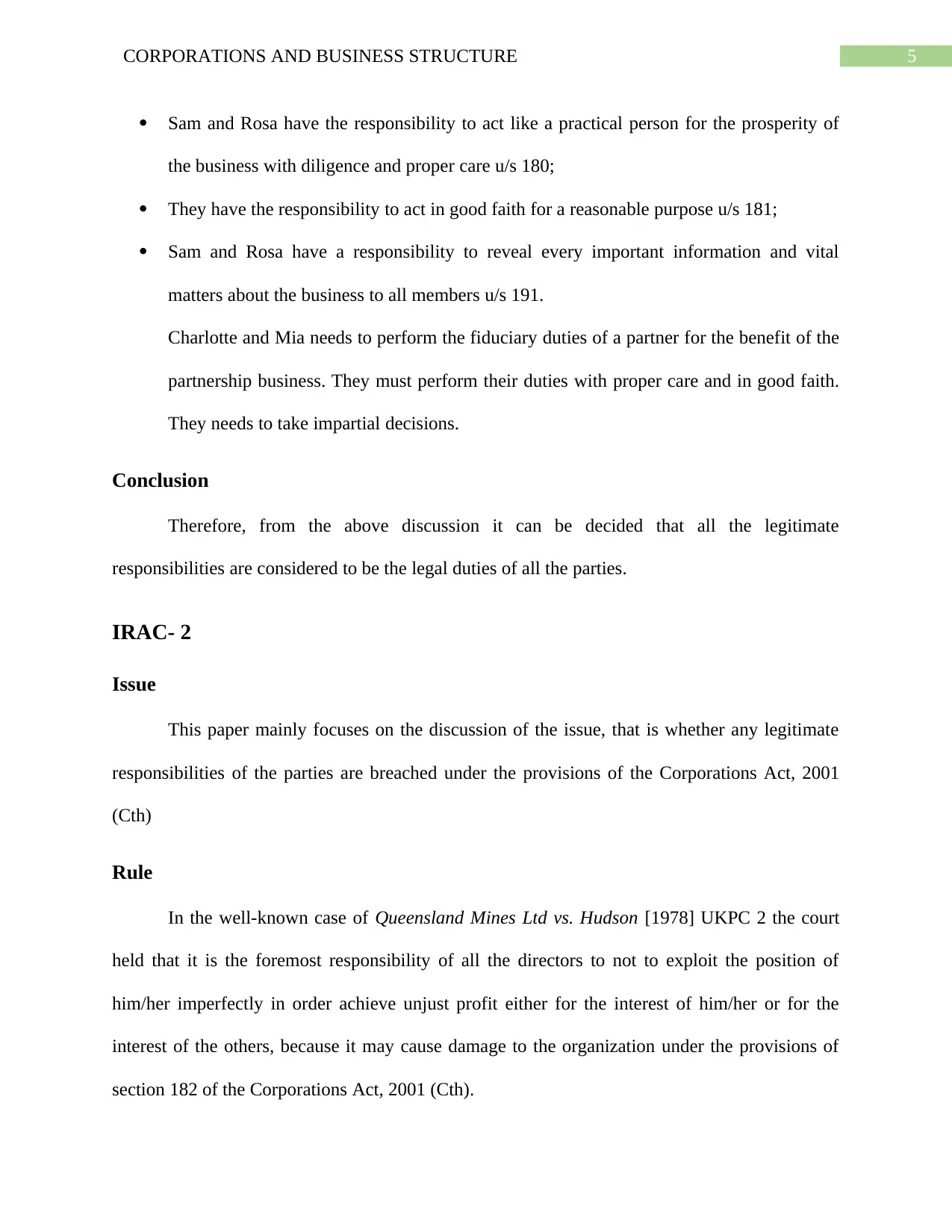
5CORPORATIONS AND BUSINESS STRUCTURE
Sam and Rosa have the responsibility to act like a practical person for the prosperity of
the business with diligence and proper care u/s 180;
They have the responsibility to act in good faith for a reasonable purpose u/s 181;
Sam and Rosa have a responsibility to reveal every important information and vital
matters about the business to all members u/s 191.
Charlotte and Mia needs to perform the fiduciary duties of a partner for the benefit of the
partnership business. They must perform their duties with proper care and in good faith.
They needs to take impartial decisions.
Conclusion
Therefore, from the above discussion it can be decided that all the legitimate
responsibilities are considered to be the legal duties of all the parties.
IRAC- 2
Issue
This paper mainly focuses on the discussion of the issue, that is whether any legitimate
responsibilities of the parties are breached under the provisions of the Corporations Act, 2001
(Cth)
Rule
In the well-known case of Queensland Mines Ltd vs. Hudson [1978] UKPC 2 the court
held that it is the foremost responsibility of all the directors to not to exploit the position of
him/her imperfectly in order achieve unjust profit either for the interest of him/her or for the
interest of the others, because it may cause damage to the organization under the provisions of
section 182 of the Corporations Act, 2001 (Cth).
Sam and Rosa have the responsibility to act like a practical person for the prosperity of
the business with diligence and proper care u/s 180;
They have the responsibility to act in good faith for a reasonable purpose u/s 181;
Sam and Rosa have a responsibility to reveal every important information and vital
matters about the business to all members u/s 191.
Charlotte and Mia needs to perform the fiduciary duties of a partner for the benefit of the
partnership business. They must perform their duties with proper care and in good faith.
They needs to take impartial decisions.
Conclusion
Therefore, from the above discussion it can be decided that all the legitimate
responsibilities are considered to be the legal duties of all the parties.
IRAC- 2
Issue
This paper mainly focuses on the discussion of the issue, that is whether any legitimate
responsibilities of the parties are breached under the provisions of the Corporations Act, 2001
(Cth)
Rule
In the well-known case of Queensland Mines Ltd vs. Hudson [1978] UKPC 2 the court
held that it is the foremost responsibility of all the directors to not to exploit the position of
him/her imperfectly in order achieve unjust profit either for the interest of him/her or for the
interest of the others, because it may cause damage to the organization under the provisions of
section 182 of the Corporations Act, 2001 (Cth).
⊘ This is a preview!⊘
Do you want full access?
Subscribe today to unlock all pages.

Trusted by 1+ million students worldwide
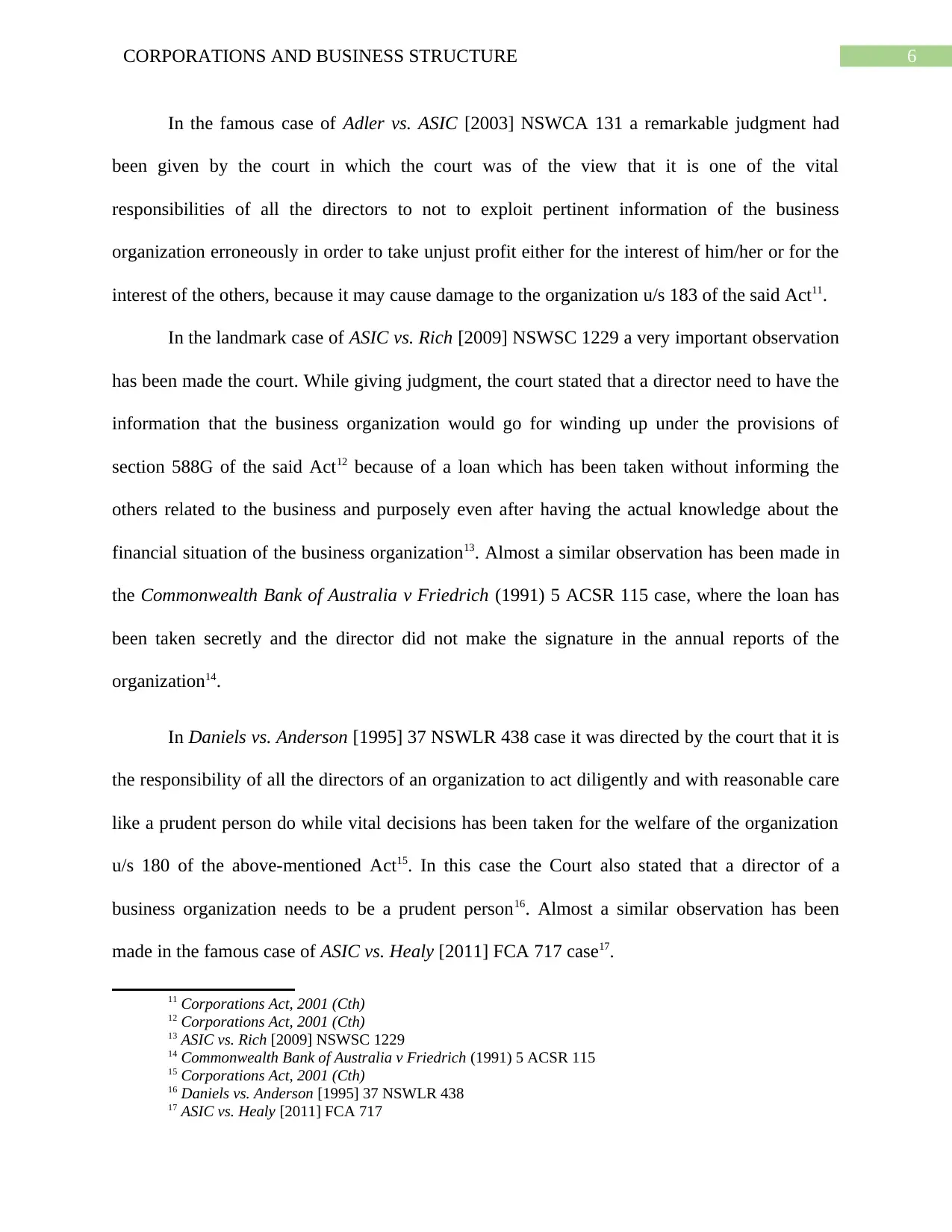
6CORPORATIONS AND BUSINESS STRUCTURE
In the famous case of Adler vs. ASIC [2003] NSWCA 131 a remarkable judgment had
been given by the court in which the court was of the view that it is one of the vital
responsibilities of all the directors to not to exploit pertinent information of the business
organization erroneously in order to take unjust profit either for the interest of him/her or for the
interest of the others, because it may cause damage to the organization u/s 183 of the said Act11.
In the landmark case of ASIC vs. Rich [2009] NSWSC 1229 a very important observation
has been made the court. While giving judgment, the court stated that a director need to have the
information that the business organization would go for winding up under the provisions of
section 588G of the said Act12 because of a loan which has been taken without informing the
others related to the business and purposely even after having the actual knowledge about the
financial situation of the business organization13. Almost a similar observation has been made in
the Commonwealth Bank of Australia v Friedrich (1991) 5 ACSR 115 case, where the loan has
been taken secretly and the director did not make the signature in the annual reports of the
organization14.
In Daniels vs. Anderson [1995] 37 NSWLR 438 case it was directed by the court that it is
the responsibility of all the directors of an organization to act diligently and with reasonable care
like a prudent person do while vital decisions has been taken for the welfare of the organization
u/s 180 of the above-mentioned Act15. In this case the Court also stated that a director of a
business organization needs to be a prudent person16. Almost a similar observation has been
made in the famous case of ASIC vs. Healy [2011] FCA 717 case17.
11 Corporations Act, 2001 (Cth)
12 Corporations Act, 2001 (Cth)
13 ASIC vs. Rich [2009] NSWSC 1229
14 Commonwealth Bank of Australia v Friedrich (1991) 5 ACSR 115
15 Corporations Act, 2001 (Cth)
16 Daniels vs. Anderson [1995] 37 NSWLR 438
17 ASIC vs. Healy [2011] FCA 717
In the famous case of Adler vs. ASIC [2003] NSWCA 131 a remarkable judgment had
been given by the court in which the court was of the view that it is one of the vital
responsibilities of all the directors to not to exploit pertinent information of the business
organization erroneously in order to take unjust profit either for the interest of him/her or for the
interest of the others, because it may cause damage to the organization u/s 183 of the said Act11.
In the landmark case of ASIC vs. Rich [2009] NSWSC 1229 a very important observation
has been made the court. While giving judgment, the court stated that a director need to have the
information that the business organization would go for winding up under the provisions of
section 588G of the said Act12 because of a loan which has been taken without informing the
others related to the business and purposely even after having the actual knowledge about the
financial situation of the business organization13. Almost a similar observation has been made in
the Commonwealth Bank of Australia v Friedrich (1991) 5 ACSR 115 case, where the loan has
been taken secretly and the director did not make the signature in the annual reports of the
organization14.
In Daniels vs. Anderson [1995] 37 NSWLR 438 case it was directed by the court that it is
the responsibility of all the directors of an organization to act diligently and with reasonable care
like a prudent person do while vital decisions has been taken for the welfare of the organization
u/s 180 of the above-mentioned Act15. In this case the Court also stated that a director of a
business organization needs to be a prudent person16. Almost a similar observation has been
made in the famous case of ASIC vs. Healy [2011] FCA 717 case17.
11 Corporations Act, 2001 (Cth)
12 Corporations Act, 2001 (Cth)
13 ASIC vs. Rich [2009] NSWSC 1229
14 Commonwealth Bank of Australia v Friedrich (1991) 5 ACSR 115
15 Corporations Act, 2001 (Cth)
16 Daniels vs. Anderson [1995] 37 NSWLR 438
17 ASIC vs. Healy [2011] FCA 717
Paraphrase This Document
Need a fresh take? Get an instant paraphrase of this document with our AI Paraphraser
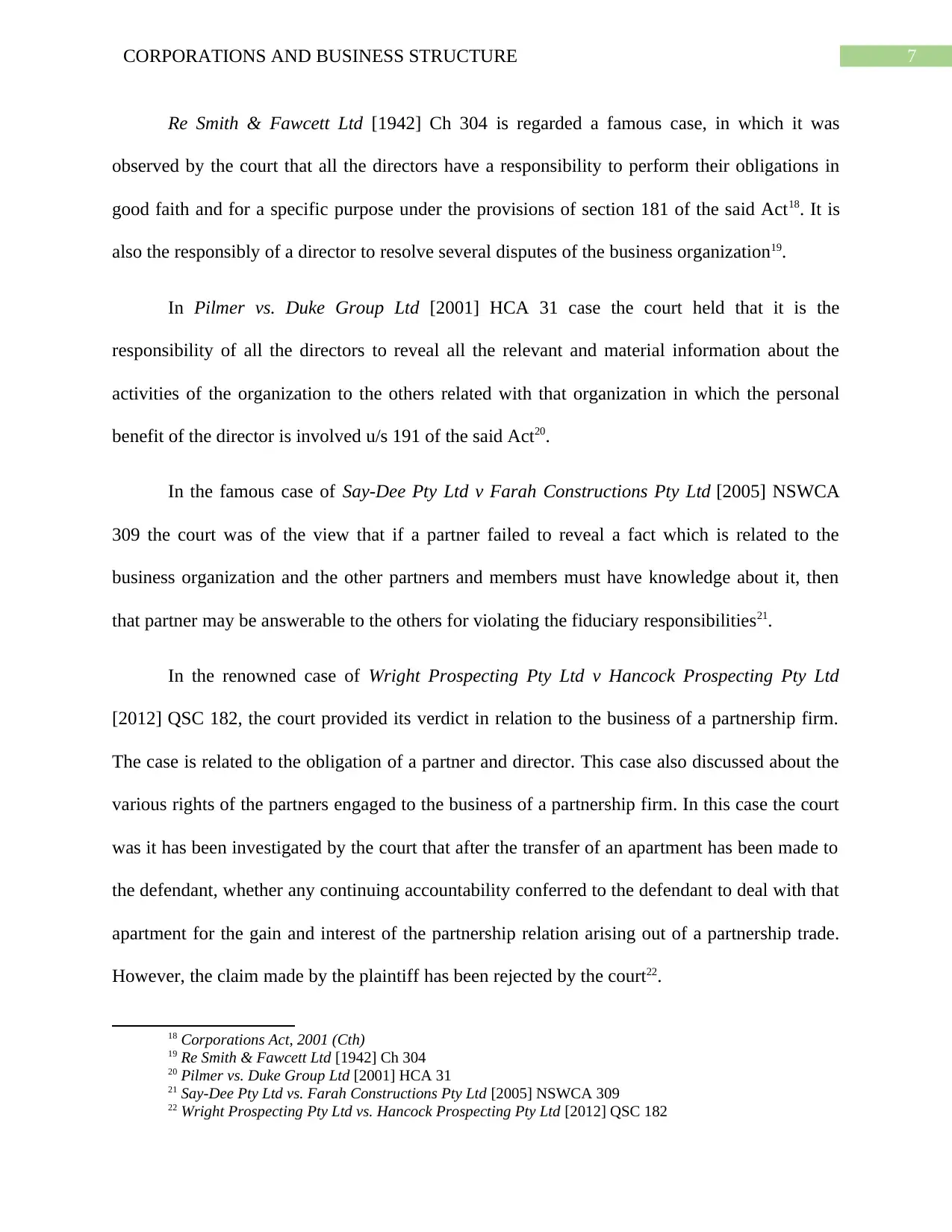
7CORPORATIONS AND BUSINESS STRUCTURE
Re Smith & Fawcett Ltd [1942] Ch 304 is regarded a famous case, in which it was
observed by the court that all the directors have a responsibility to perform their obligations in
good faith and for a specific purpose under the provisions of section 181 of the said Act18. It is
also the responsibly of a director to resolve several disputes of the business organization19.
In Pilmer vs. Duke Group Ltd [2001] HCA 31 case the court held that it is the
responsibility of all the directors to reveal all the relevant and material information about the
activities of the organization to the others related with that organization in which the personal
benefit of the director is involved u/s 191 of the said Act20.
In the famous case of Say-Dee Pty Ltd v Farah Constructions Pty Ltd [2005] NSWCA
309 the court was of the view that if a partner failed to reveal a fact which is related to the
business organization and the other partners and members must have knowledge about it, then
that partner may be answerable to the others for violating the fiduciary responsibilities21.
In the renowned case of Wright Prospecting Pty Ltd v Hancock Prospecting Pty Ltd
[2012] QSC 182, the court provided its verdict in relation to the business of a partnership firm.
The case is related to the obligation of a partner and director. This case also discussed about the
various rights of the partners engaged to the business of a partnership firm. In this case the court
was it has been investigated by the court that after the transfer of an apartment has been made to
the defendant, whether any continuing accountability conferred to the defendant to deal with that
apartment for the gain and interest of the partnership relation arising out of a partnership trade.
However, the claim made by the plaintiff has been rejected by the court22.
18 Corporations Act, 2001 (Cth)
19 Re Smith & Fawcett Ltd [1942] Ch 304
20 Pilmer vs. Duke Group Ltd [2001] HCA 31
21 Say-Dee Pty Ltd vs. Farah Constructions Pty Ltd [2005] NSWCA 309
22 Wright Prospecting Pty Ltd vs. Hancock Prospecting Pty Ltd [2012] QSC 182
Re Smith & Fawcett Ltd [1942] Ch 304 is regarded a famous case, in which it was
observed by the court that all the directors have a responsibility to perform their obligations in
good faith and for a specific purpose under the provisions of section 181 of the said Act18. It is
also the responsibly of a director to resolve several disputes of the business organization19.
In Pilmer vs. Duke Group Ltd [2001] HCA 31 case the court held that it is the
responsibility of all the directors to reveal all the relevant and material information about the
activities of the organization to the others related with that organization in which the personal
benefit of the director is involved u/s 191 of the said Act20.
In the famous case of Say-Dee Pty Ltd v Farah Constructions Pty Ltd [2005] NSWCA
309 the court was of the view that if a partner failed to reveal a fact which is related to the
business organization and the other partners and members must have knowledge about it, then
that partner may be answerable to the others for violating the fiduciary responsibilities21.
In the renowned case of Wright Prospecting Pty Ltd v Hancock Prospecting Pty Ltd
[2012] QSC 182, the court provided its verdict in relation to the business of a partnership firm.
The case is related to the obligation of a partner and director. This case also discussed about the
various rights of the partners engaged to the business of a partnership firm. In this case the court
was it has been investigated by the court that after the transfer of an apartment has been made to
the defendant, whether any continuing accountability conferred to the defendant to deal with that
apartment for the gain and interest of the partnership relation arising out of a partnership trade.
However, the claim made by the plaintiff has been rejected by the court22.
18 Corporations Act, 2001 (Cth)
19 Re Smith & Fawcett Ltd [1942] Ch 304
20 Pilmer vs. Duke Group Ltd [2001] HCA 31
21 Say-Dee Pty Ltd vs. Farah Constructions Pty Ltd [2005] NSWCA 309
22 Wright Prospecting Pty Ltd vs. Hancock Prospecting Pty Ltd [2012] QSC 182
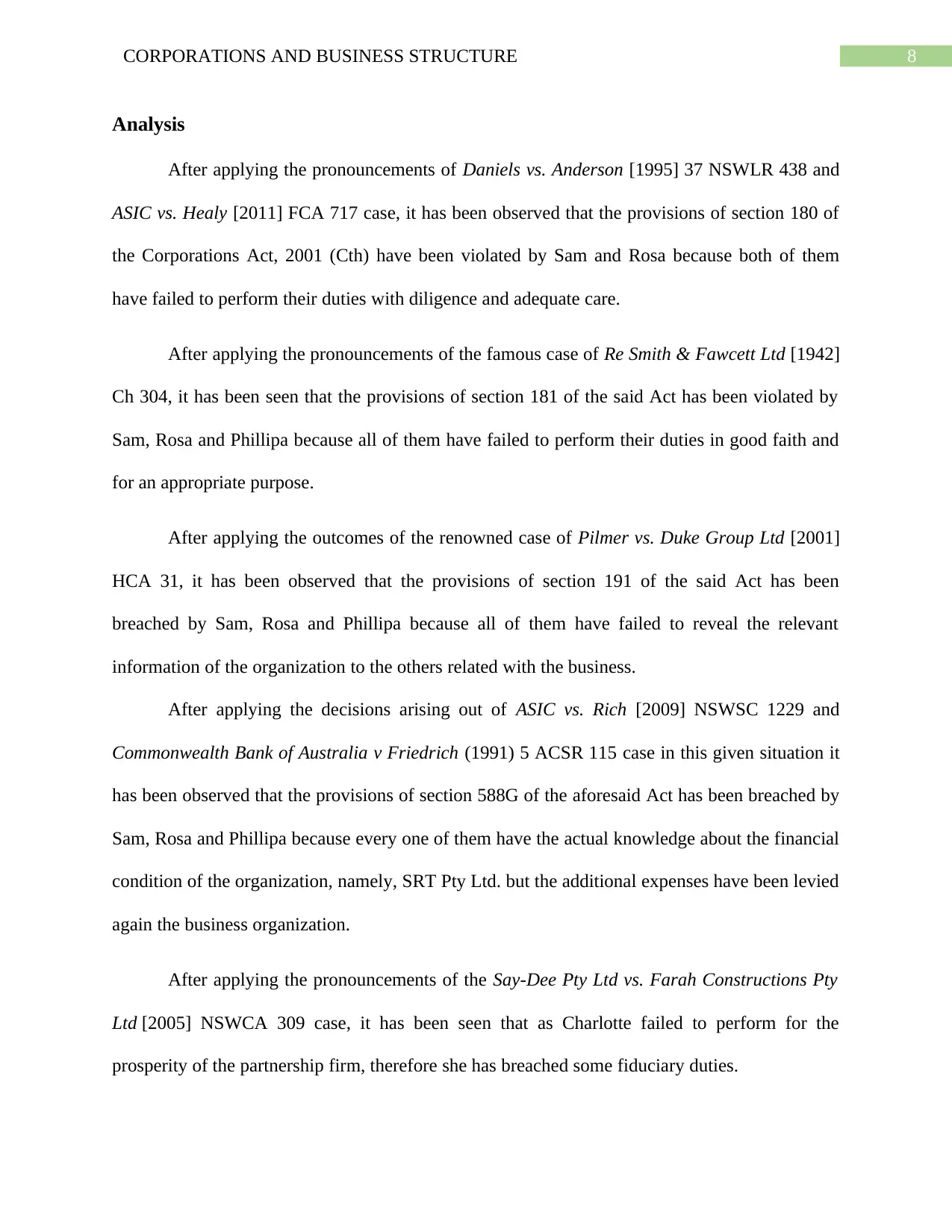
8CORPORATIONS AND BUSINESS STRUCTURE
Analysis
After applying the pronouncements of Daniels vs. Anderson [1995] 37 NSWLR 438 and
ASIC vs. Healy [2011] FCA 717 case, it has been observed that the provisions of section 180 of
the Corporations Act, 2001 (Cth) have been violated by Sam and Rosa because both of them
have failed to perform their duties with diligence and adequate care.
After applying the pronouncements of the famous case of Re Smith & Fawcett Ltd [1942]
Ch 304, it has been seen that the provisions of section 181 of the said Act has been violated by
Sam, Rosa and Phillipa because all of them have failed to perform their duties in good faith and
for an appropriate purpose.
After applying the outcomes of the renowned case of Pilmer vs. Duke Group Ltd [2001]
HCA 31, it has been observed that the provisions of section 191 of the said Act has been
breached by Sam, Rosa and Phillipa because all of them have failed to reveal the relevant
information of the organization to the others related with the business.
After applying the decisions arising out of ASIC vs. Rich [2009] NSWSC 1229 and
Commonwealth Bank of Australia v Friedrich (1991) 5 ACSR 115 case in this given situation it
has been observed that the provisions of section 588G of the aforesaid Act has been breached by
Sam, Rosa and Phillipa because every one of them have the actual knowledge about the financial
condition of the organization, namely, SRT Pty Ltd. but the additional expenses have been levied
again the business organization.
After applying the pronouncements of the Say-Dee Pty Ltd vs. Farah Constructions Pty
Ltd [2005] NSWCA 309 case, it has been seen that as Charlotte failed to perform for the
prosperity of the partnership firm, therefore she has breached some fiduciary duties.
Analysis
After applying the pronouncements of Daniels vs. Anderson [1995] 37 NSWLR 438 and
ASIC vs. Healy [2011] FCA 717 case, it has been observed that the provisions of section 180 of
the Corporations Act, 2001 (Cth) have been violated by Sam and Rosa because both of them
have failed to perform their duties with diligence and adequate care.
After applying the pronouncements of the famous case of Re Smith & Fawcett Ltd [1942]
Ch 304, it has been seen that the provisions of section 181 of the said Act has been violated by
Sam, Rosa and Phillipa because all of them have failed to perform their duties in good faith and
for an appropriate purpose.
After applying the outcomes of the renowned case of Pilmer vs. Duke Group Ltd [2001]
HCA 31, it has been observed that the provisions of section 191 of the said Act has been
breached by Sam, Rosa and Phillipa because all of them have failed to reveal the relevant
information of the organization to the others related with the business.
After applying the decisions arising out of ASIC vs. Rich [2009] NSWSC 1229 and
Commonwealth Bank of Australia v Friedrich (1991) 5 ACSR 115 case in this given situation it
has been observed that the provisions of section 588G of the aforesaid Act has been breached by
Sam, Rosa and Phillipa because every one of them have the actual knowledge about the financial
condition of the organization, namely, SRT Pty Ltd. but the additional expenses have been levied
again the business organization.
After applying the pronouncements of the Say-Dee Pty Ltd vs. Farah Constructions Pty
Ltd [2005] NSWCA 309 case, it has been seen that as Charlotte failed to perform for the
prosperity of the partnership firm, therefore she has breached some fiduciary duties.
⊘ This is a preview!⊘
Do you want full access?
Subscribe today to unlock all pages.

Trusted by 1+ million students worldwide
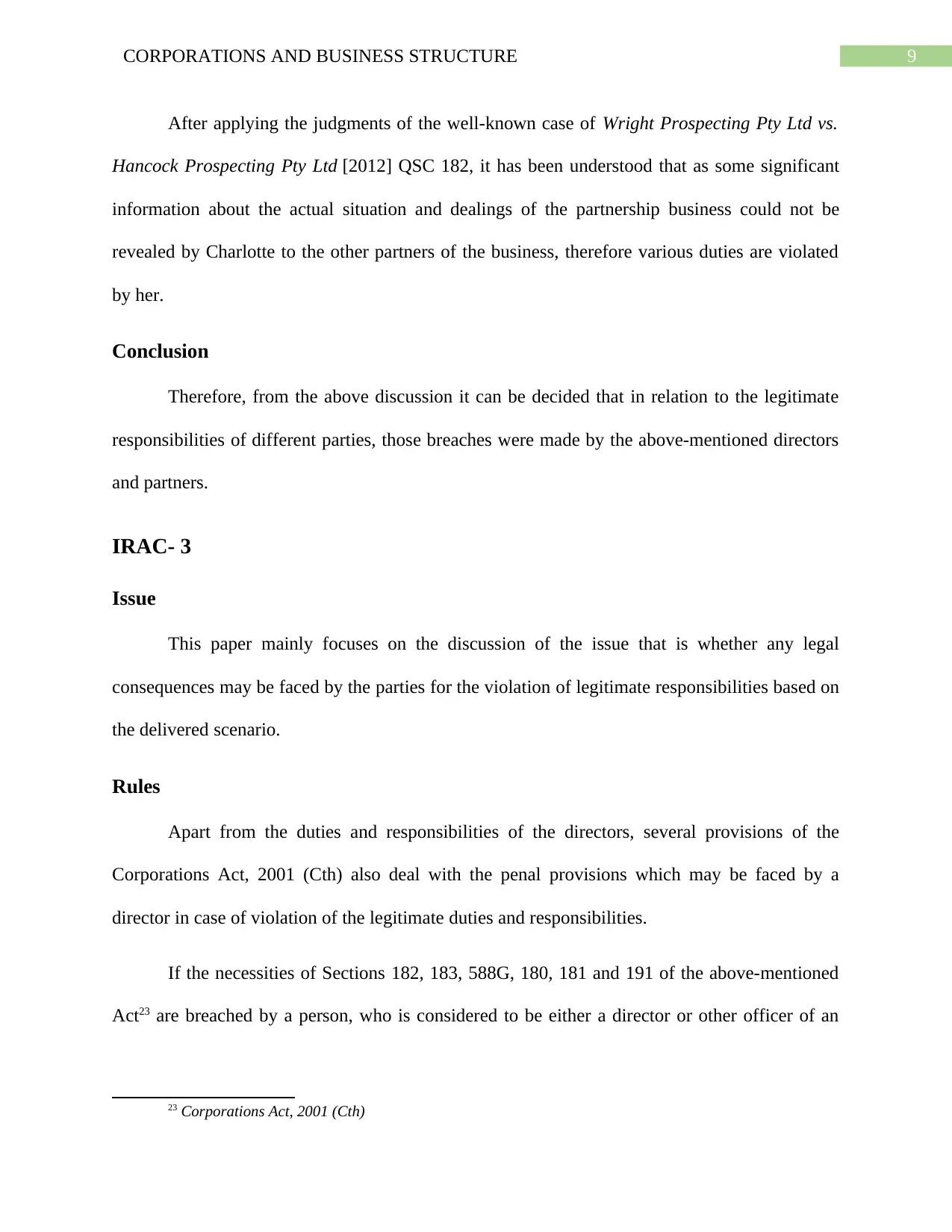
9CORPORATIONS AND BUSINESS STRUCTURE
After applying the judgments of the well-known case of Wright Prospecting Pty Ltd vs.
Hancock Prospecting Pty Ltd [2012] QSC 182, it has been understood that as some significant
information about the actual situation and dealings of the partnership business could not be
revealed by Charlotte to the other partners of the business, therefore various duties are violated
by her.
Conclusion
Therefore, from the above discussion it can be decided that in relation to the legitimate
responsibilities of different parties, those breaches were made by the above-mentioned directors
and partners.
IRAC- 3
Issue
This paper mainly focuses on the discussion of the issue that is whether any legal
consequences may be faced by the parties for the violation of legitimate responsibilities based on
the delivered scenario.
Rules
Apart from the duties and responsibilities of the directors, several provisions of the
Corporations Act, 2001 (Cth) also deal with the penal provisions which may be faced by a
director in case of violation of the legitimate duties and responsibilities.
If the necessities of Sections 182, 183, 588G, 180, 181 and 191 of the above-mentioned
Act23 are breached by a person, who is considered to be either a director or other officer of an
23 Corporations Act, 2001 (Cth)
After applying the judgments of the well-known case of Wright Prospecting Pty Ltd vs.
Hancock Prospecting Pty Ltd [2012] QSC 182, it has been understood that as some significant
information about the actual situation and dealings of the partnership business could not be
revealed by Charlotte to the other partners of the business, therefore various duties are violated
by her.
Conclusion
Therefore, from the above discussion it can be decided that in relation to the legitimate
responsibilities of different parties, those breaches were made by the above-mentioned directors
and partners.
IRAC- 3
Issue
This paper mainly focuses on the discussion of the issue that is whether any legal
consequences may be faced by the parties for the violation of legitimate responsibilities based on
the delivered scenario.
Rules
Apart from the duties and responsibilities of the directors, several provisions of the
Corporations Act, 2001 (Cth) also deal with the penal provisions which may be faced by a
director in case of violation of the legitimate duties and responsibilities.
If the necessities of Sections 182, 183, 588G, 180, 181 and 191 of the above-mentioned
Act23 are breached by a person, who is considered to be either a director or other officer of an
23 Corporations Act, 2001 (Cth)
Paraphrase This Document
Need a fresh take? Get an instant paraphrase of this document with our AI Paraphraser
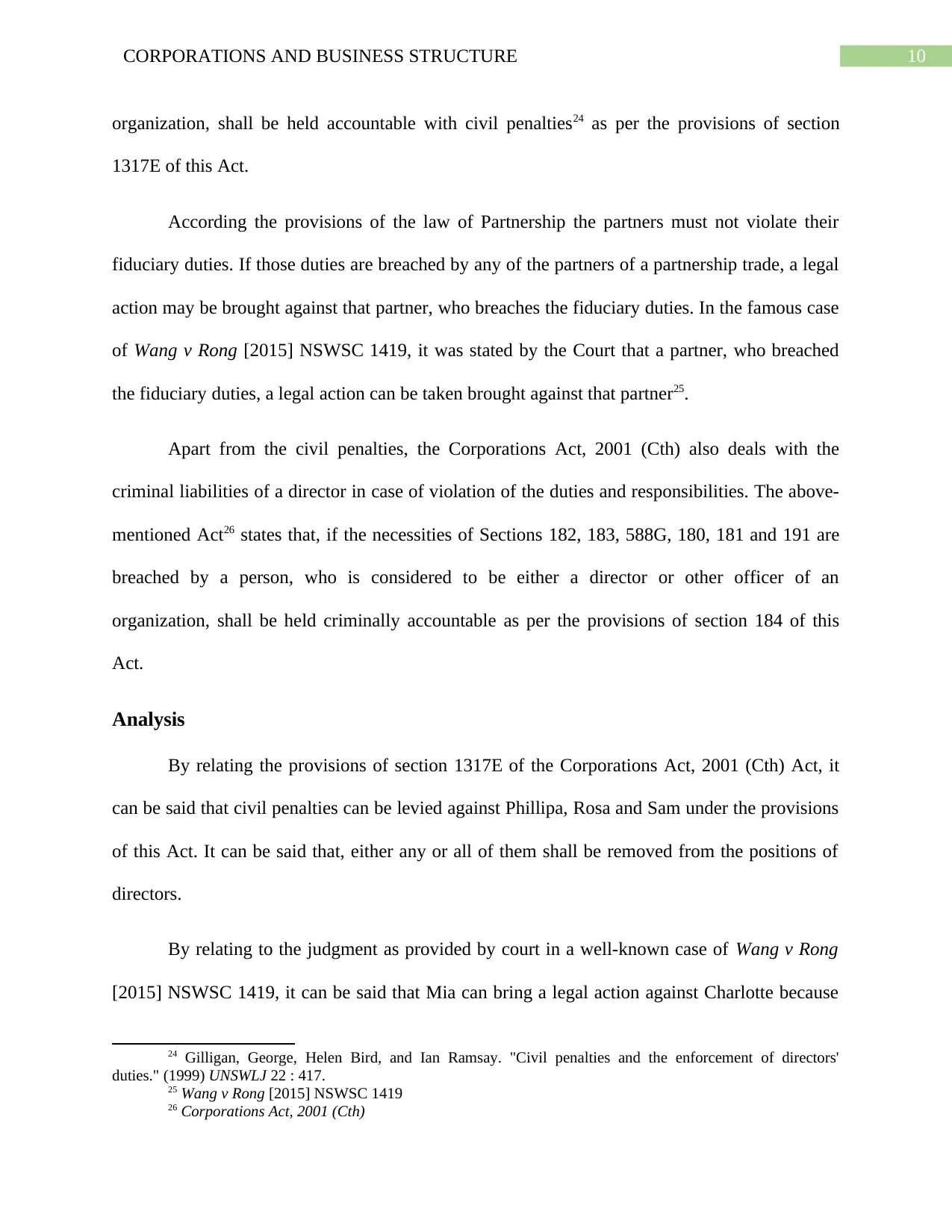
10CORPORATIONS AND BUSINESS STRUCTURE
organization, shall be held accountable with civil penalties24 as per the provisions of section
1317E of this Act.
According the provisions of the law of Partnership the partners must not violate their
fiduciary duties. If those duties are breached by any of the partners of a partnership trade, a legal
action may be brought against that partner, who breaches the fiduciary duties. In the famous case
of Wang v Rong [2015] NSWSC 1419, it was stated by the Court that a partner, who breached
the fiduciary duties, a legal action can be taken brought against that partner25.
Apart from the civil penalties, the Corporations Act, 2001 (Cth) also deals with the
criminal liabilities of a director in case of violation of the duties and responsibilities. The above-
mentioned Act26 states that, if the necessities of Sections 182, 183, 588G, 180, 181 and 191 are
breached by a person, who is considered to be either a director or other officer of an
organization, shall be held criminally accountable as per the provisions of section 184 of this
Act.
Analysis
By relating the provisions of section 1317E of the Corporations Act, 2001 (Cth) Act, it
can be said that civil penalties can be levied against Phillipa, Rosa and Sam under the provisions
of this Act. It can be said that, either any or all of them shall be removed from the positions of
directors.
By relating to the judgment as provided by court in a well-known case of Wang v Rong
[2015] NSWSC 1419, it can be said that Mia can bring a legal action against Charlotte because
24 Gilligan, George, Helen Bird, and Ian Ramsay. "Civil penalties and the enforcement of directors'
duties." (1999) UNSWLJ 22 : 417.
25 Wang v Rong [2015] NSWSC 1419
26 Corporations Act, 2001 (Cth)
organization, shall be held accountable with civil penalties24 as per the provisions of section
1317E of this Act.
According the provisions of the law of Partnership the partners must not violate their
fiduciary duties. If those duties are breached by any of the partners of a partnership trade, a legal
action may be brought against that partner, who breaches the fiduciary duties. In the famous case
of Wang v Rong [2015] NSWSC 1419, it was stated by the Court that a partner, who breached
the fiduciary duties, a legal action can be taken brought against that partner25.
Apart from the civil penalties, the Corporations Act, 2001 (Cth) also deals with the
criminal liabilities of a director in case of violation of the duties and responsibilities. The above-
mentioned Act26 states that, if the necessities of Sections 182, 183, 588G, 180, 181 and 191 are
breached by a person, who is considered to be either a director or other officer of an
organization, shall be held criminally accountable as per the provisions of section 184 of this
Act.
Analysis
By relating the provisions of section 1317E of the Corporations Act, 2001 (Cth) Act, it
can be said that civil penalties can be levied against Phillipa, Rosa and Sam under the provisions
of this Act. It can be said that, either any or all of them shall be removed from the positions of
directors.
By relating to the judgment as provided by court in a well-known case of Wang v Rong
[2015] NSWSC 1419, it can be said that Mia can bring a legal action against Charlotte because
24 Gilligan, George, Helen Bird, and Ian Ramsay. "Civil penalties and the enforcement of directors'
duties." (1999) UNSWLJ 22 : 417.
25 Wang v Rong [2015] NSWSC 1419
26 Corporations Act, 2001 (Cth)
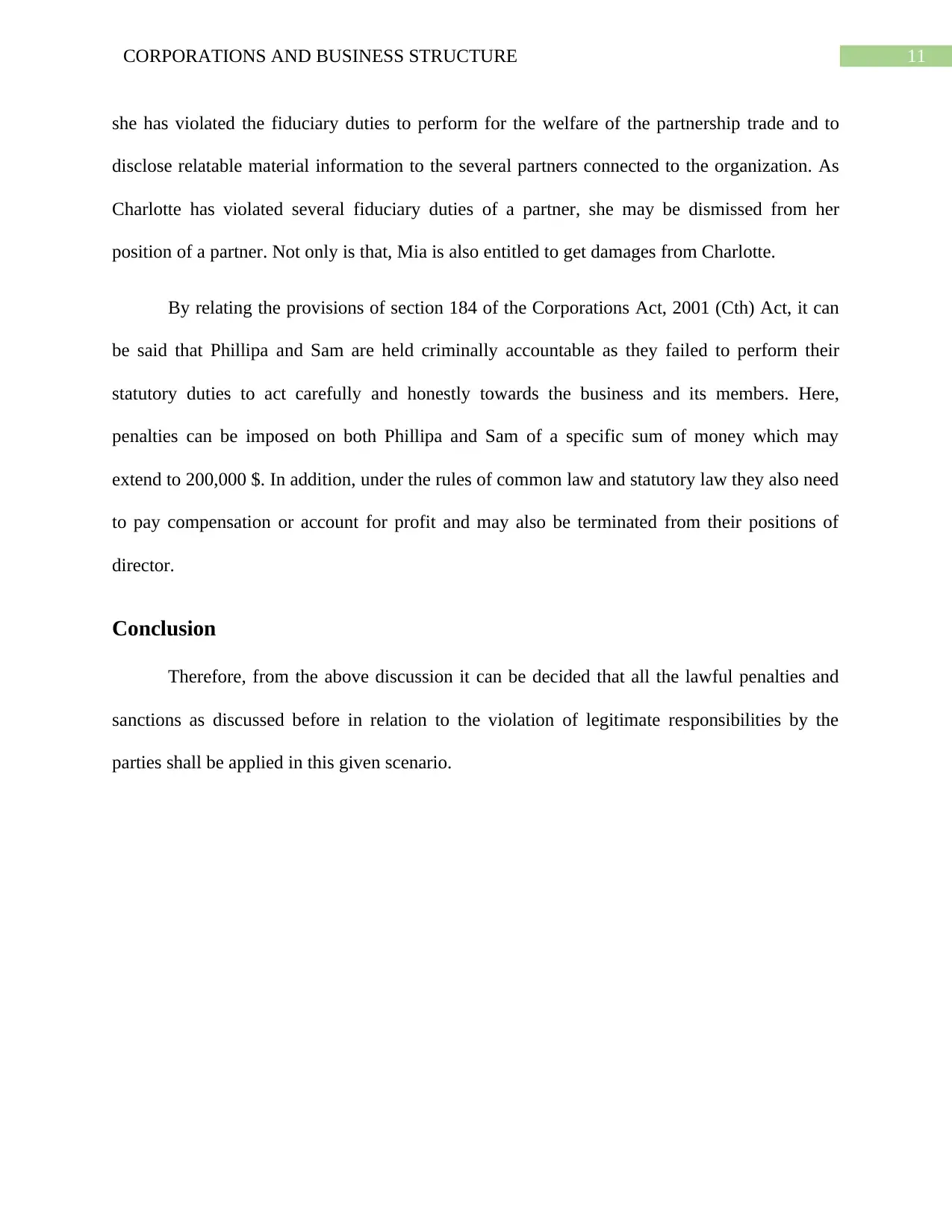
11CORPORATIONS AND BUSINESS STRUCTURE
she has violated the fiduciary duties to perform for the welfare of the partnership trade and to
disclose relatable material information to the several partners connected to the organization. As
Charlotte has violated several fiduciary duties of a partner, she may be dismissed from her
position of a partner. Not only is that, Mia is also entitled to get damages from Charlotte.
By relating the provisions of section 184 of the Corporations Act, 2001 (Cth) Act, it can
be said that Phillipa and Sam are held criminally accountable as they failed to perform their
statutory duties to act carefully and honestly towards the business and its members. Here,
penalties can be imposed on both Phillipa and Sam of a specific sum of money which may
extend to 200,000 $. In addition, under the rules of common law and statutory law they also need
to pay compensation or account for profit and may also be terminated from their positions of
director.
Conclusion
Therefore, from the above discussion it can be decided that all the lawful penalties and
sanctions as discussed before in relation to the violation of legitimate responsibilities by the
parties shall be applied in this given scenario.
she has violated the fiduciary duties to perform for the welfare of the partnership trade and to
disclose relatable material information to the several partners connected to the organization. As
Charlotte has violated several fiduciary duties of a partner, she may be dismissed from her
position of a partner. Not only is that, Mia is also entitled to get damages from Charlotte.
By relating the provisions of section 184 of the Corporations Act, 2001 (Cth) Act, it can
be said that Phillipa and Sam are held criminally accountable as they failed to perform their
statutory duties to act carefully and honestly towards the business and its members. Here,
penalties can be imposed on both Phillipa and Sam of a specific sum of money which may
extend to 200,000 $. In addition, under the rules of common law and statutory law they also need
to pay compensation or account for profit and may also be terminated from their positions of
director.
Conclusion
Therefore, from the above discussion it can be decided that all the lawful penalties and
sanctions as discussed before in relation to the violation of legitimate responsibilities by the
parties shall be applied in this given scenario.
⊘ This is a preview!⊘
Do you want full access?
Subscribe today to unlock all pages.

Trusted by 1+ million students worldwide
1 out of 14
Related Documents
Your All-in-One AI-Powered Toolkit for Academic Success.
+13062052269
info@desklib.com
Available 24*7 on WhatsApp / Email
![[object Object]](/_next/static/media/star-bottom.7253800d.svg)
Unlock your academic potential
Copyright © 2020–2025 A2Z Services. All Rights Reserved. Developed and managed by ZUCOL.





